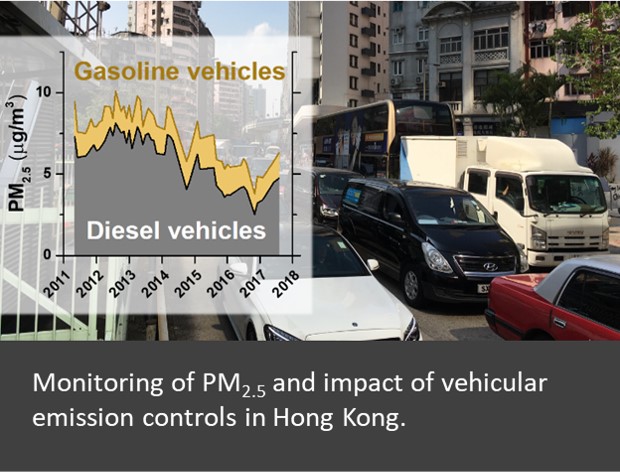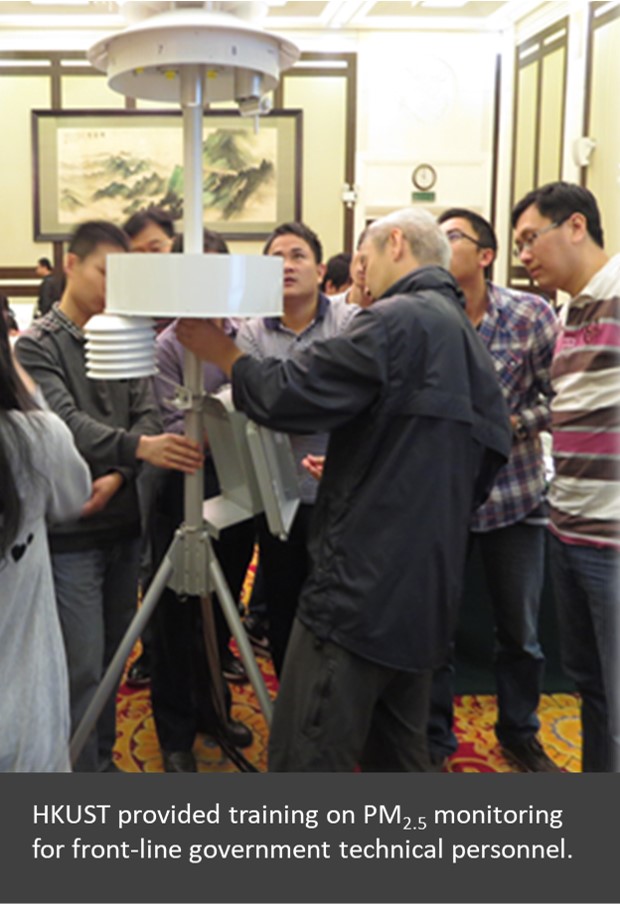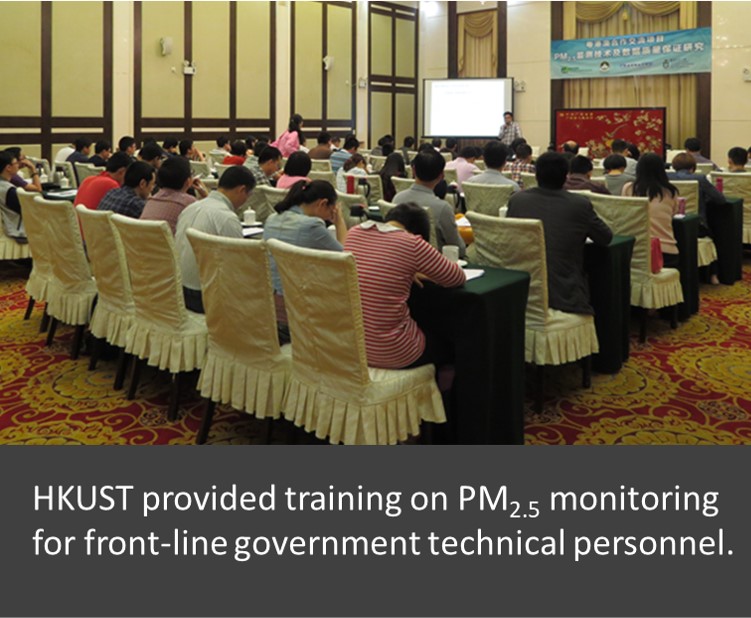Tracking Air Pollution in Hong Kong and the Pearl River Delta - Foundation Laying for Evidence-based Air Quality Control Policies




Summary of Impact
Air pollution caused by small particulate matter (PM) is a major public health concern worldwide and especially so in Hong Kong and the Pearl River Delta. Knowledge of PM concentration levels and sources is integral to good public policy for air quality protection. Prof Jianzhen Yu's group has developed and shared its expertise in atmospheric measurement of PM components, with substantial impact on public policy, the environment, professional practice and public health. The Environmental Protection Department of the Government of the HKSAR has been relying on HKUST to provide analytical data for its PM2.5 monitoring network since 2011, and more recently to monitor impact of the diesel vehicle control program on air quality. The group has also helped governmental environmental monitoring agencies in Macao, Guangdong Province, and the Yangtze River Delta area address the air pollution challenge by transferring their analytical know-how through sharing standard operating procedures and hands-on training.
Underpinning Research
PM pollution comes from both direct emission sources and formation through atmospheric oxidation of gaseous precursors, leading to varied chemical composition in time and in space. Monitoring the levels and chemical composition of PM and subsequently analyzing the data for tracking pollution sources are integral to developing air quality management policy and strategies and to assessing the burden on public health.
The analytical challenge for tracking chemical composition of PM is rooted in the large span (six order of magnitude) of abundance in the concentration of individual compounds and the desire for simple quantification methods to enable analysis of a large number of samples. Atmospheric concentrations of individual components range from less than one-tenth of a nanogram per cubic meter for organic tracers to tens of micrograms per cubic meter for major species (e.g. sulfate), making it necessary to resort to multiple quantification strategies.
Over the past 20 years, Prof Yu (joined HKUST 1999), a chemist and member of the multidisciplinary Air Group under the Institute for the Environment, and her team of researchers have built up an array of analytical capacities encompassing both major components, such as elemental carbon (EC) and organic carbon (OC), and trace-level organic compounds. Prof Yu pioneered research on the pyrolytic effects of organic aerosols in thermal/optical transmittance carbon analysis [See Section 3, R1 for example] and made systematic evaluation of two commonly used analysis protocols using 1,300+ actual measurements [R2]. These studies enabled the creation of equations to compare data by different protocols, making it possible to connect measurement time series of more than two decades.
Prof Yu's group developed multiple analytical methods for individual organic compounds that have significantly expanded the list of identified organic compounds or reduced analysis time. One example is the development of an in-injection port thermal desorption gas chromatography/mass spectrometric (TD-GCMS) method for aerosol-phase nonpolar organic compounds (e.g., polycyclic aromatic hydrocarbons) [R3, R4]. This method eliminates the lengthy and laborious sample pre-treatment steps in the conventional solvent extraction-based method, removing a bottleneck to the analysis of large numbers of aerosol samples. Subsequently, this method has been used in numerous PM source characterization and health effect studies by more than 20 research groups and government laboratories around the world. The analytical capabilities have been solidified through 15+ field studies in different atmospheric environments, both clean and polluted [e.g. R5]. The accumulated experience has laid solid ground for providing reliable analytical support for the PM2.5 chemical speciation network in Hong Kong, Macao, and Guangdong Province, ensuring good-quality measurements of PM2.5 pollutant components (PM2.5 being particles with a diameter of less than 2.5 micrometers). This in turn drives effective public policy for air quality protection.
Prof Yu's group is among the leading groups internationally pushing capability in accurately apportioning PM sources through incorporating unique organic tracers in statistical data modelling [e.g., R6]. The suite of organic tracers provides unique fingerprints for common combustion sources (e.g., coal combustion, vehicular emissions, and biomass burning) and secondarily formed PM, which are otherwise un-resolved and prevent a good grasp of their individual contributions to PM pollution.
Key Research Grants and Funding
This research has been funded by four RGC/GRF grants, 2003-12, total value HK$2,166,000. EPD funded (a) “Organic Speciation and Source Apportionment of Fine Suspended Particulates in HK”, HK$500k, 2010-12; (b) “Fine Particulate Matter Sample (PM2.5) Chemical Analysis”, HK$6,807k, 7 annual projects, 2011-19; (c) “Integrated Assessment on Roadside Air Quality”, HK$1,410k, 2012-16; (d) “Guangdong-Macao-Hong Kong Regional Cooperation Program-PM2.5 Monitoring and Data Quality Assurance Exchange Program”, HK$1,400k, 2014-15; (f) “Characterization of Vehicular Emissions in Selected Roadside and Ambient Environment in Hong Kong”, HK$1,410k, 2015-17. Macao Meteorological and Geophysical Bureau funded “PM2.5 Study for Air Quality Improvement in the Pearl River Delta Region - Field Sampling and Laboratory Analysis of PM2.5 Samples in Macao”, HK$2,000k, 2014-16.
Details of the Impact
PM are tiny particles suspended in the atmosphere that can penetrate deep into our respiratory system, eliciting adverse health effects. They also scatter sunlight, degrading visibility locally and regionally. According to the World Health Organization (WHO), outdoor PM pollution is the seventh leading risk factor for global deaths, responsible for 2.9 million deaths and with 64% of them occurring in Asia, especially China and India. The WHO guideline stipulates that PM2.5 not exceed 10 μg/m3 annual mean, or 25 μg/m3 24-hour mean to protect public health. In Hong Kong, the annual PM2.5 concentration was 31.3-43.1 μg/m3 in 2011 and dropped to 18.7-27.2 μg/m3 in 2017 across the city's six-site monitoring network. Despite this progress, Hong Kong residents are still exposed to unhealthy levels of PM2.5 pollution, exceeding the WHO guideline by 87-170%.
The above data demonstrates the importance of careful monitoring data for informing the public and policymakers about the status of air pollution. As the main lab in Hong Kong carrying out such analytical work, Prof Yu’s team has played an indispensable role in generating this essential dataset for policymaking. Between 2011-14, and 2016-17, they generated and authored the annual PM2.5 Speciation Study in Hong Kong reports for the EPD. EPD affirmed significant impact on public policy, professional practice, the environment, and public health from this and other work the team had conducted, which had "provided the scientific basis for our decisions on environmental protection issues and contributed significantly to improving air quality in Hong Kong which benefits the entire community". The study results provided valuable insights for EPD to formulate policies that would help Hong Kong further improve air quality and progressively tighten our air quality standards towards the goal of meeting the WHO ultimate targets.
Prof Yu's research has contributed to the scientific consensus that Hong Kong faces two air pollution issues, namely local street-level pollution and regional smog, knowledge that has two clear policy implications for improving the city's air quality. First, regional collaboration is a necessary step in bringing down PM2.5 pollution in Hong Kong, as pollution sources transported from the Pearl River Delta region contributed a significant proportion. Second, reducing emissions from vehicles in the city will alleviate part of PM2.5 pollution in urban locations and could potentially lower the pollution level by up to ~9 μg/m3.
Prof Yu's team has played key roles in both regional collaboration efforts and the local vehicular emission reduction program. The team has been trusted by EPD with the task of monitoring carbonaceous PM2.5 pollution levels in roadside environments since 2011 to evaluate the government’s Diesel Commercial Vehicles (DCV) Replacement Program to phase-out ~82,000 pre-euro IV DCVs between March 2014 and the end of 2019. EPD attested that the roadside monitoring by Prof Yu's team had generated a “one-of-a-kind dataset”, facilitating evaluation of the new control: “Verifying the effectiveness of the control program is an integral part and Prof Yu's work was especially valuable for this purpose.”
Regional cooperation is vital to improve air quality in Hong Kong. HKUST has played an important bridging role in facilitating information exchange and technology transfer between the governments of Hong Kong, Macao, and Guangdong. This involved the Macao government calling upon HKUST in 2015 to conduct its first comprehensive PM2.5 composition monitoring survey. The Macao Geophysical and Meteorological Bureau attested the impact: “This project has helped us gain a more comprehensive understanding on the major sources and formation mechanisms of PM2.5 in Macao.” It resulted in a “robust data foundation for Macao government to formulate effective pollution control measures”.
Prof Yu's team was also tasked with leading the Guangdong-Macao-Hong Kong Regional Cooperation Program – PM2.5 monitoring and data quality assurance exchange program. It provided on-site demonstration and training on monitoring and data analysis to front-line technical personnel in county-level monitoring units in Guangdong Province, from March 2014 to February 2015, with further training in January 2019, in collaboration with the Guangdong Environmental Monitoring Center (GDEMC). This program has helped vital capacity-building in Guangdong. A Senior Engineer with the Center attested: “Thanks to the collaboration … our center has now established advanced analytical techniques and capabilities in sampling and monitoring for PM2.5 chemical composition.”
This collaboration led to the book, Standard Operating Procedures for Monitoring Secondary Air Pollution (大气二次污染手工监测标准操作程序), to be published in early 2020. The book provides technical guidance for monitoring agencies throughout China, sharing Hong Kong and now Guangdong’s lead in technical proficiency in PM2.5 monitoring and control. The wide-reaching impact for addressing environmental challenges in China is acknowledged by the Vice Minister of Ecology and Environment of China, HUANG Runqiu, in his preface: “…results from the special project research have been successfully applied in work at the various levels of environmental protection units. They have provided important technological support in solving our nation’s environmental problems and in improving environmental management.”
Wider-reaching impact in China has also been achieved through Prof Yu’s collaboration with Shanghai Academy of Environmental Sciences (SAES), under the Shanghai Municipal Bureau of Ecology and Environment, which is tasked with combating air pollution in the Yangtze River Delta region. The Research Institute of Atmospheric Environment, SAES, writes in testimony: “This collaboration has benefited us in developing and improving our capabilities in monitoring particulate matter (PM) pollution.”
References to the Research
[R1] Yu, JZ; Xu, JH, Yang, H. Charring characteristics of atmospheric organic particulate matter in thermal analysis. Environ. Sci. Technol., 36, 2002, 754-761. [132 citations, Source: Web of Science, 2019/09/22]
[R2] Wu C, Huang, XHH, Ng, WM, Griffith, SM, Yu, JZ. Inter-comparison of NIOSH and IMPROVE protocols for OC and EC determination: implications for inter-protocol data conversion Atmos. Meas. Tech., 46, 2012, 610–621. [15 citations, Source: Web of Science, 2019/09/22]
[R3] Ho, SSH., Yu, JZ, In-injection port thermal desorption with subsequent gas chromatography-mass spectrometric analysis of polycyclic aromatic hydrocarbons and n-alkanes in atmospheric aerosol samples. J. Chromatogr. A, 1059, 2004, 121-129. [98 citations, Source: Web of Science, 2019/09/22]
[R4] Ho, SSH, Yu, JZ, Chow, JC, Watson, JG, Zielinska, B, Sit, EHL, Schauer, JJ, Evaluation of an in-injection port thermal desorption GC-MS method for analysis of non-polar organic compounds in ambient aerosol samples, J. Chromatogra. A, 1200, 2008, 217-227. [89 citations, Source: Web of Science, 2019/09/22]
[R5] Yang, H., Yu, JZ, Ho, SSH, Xu, JH, Wu, WS, Wan, CH, Wang, XD, Wang, XR, Wang, LS, The chemical composition of inorganic and carbonaceous materials in PM2.5 in Nanjing, China, Atmos. Environ. 39, 2005, 3735-3749. [196 citations, Source: Web of Science, 2019/09/22]
[R6] Wang, QQ, Huang, XHH, Zhang, T, Zhang, QY, Feng, YM, Yuan, ZB, Wu, D, Lau, AKH, Yu, JZ, Organic tracer-based source analysis of PM2.5 organic and elemental carbon: A case study at Dongguan in the Pearl River Delta, China., Atmos. Environ., 118, 2015, 164-175. [23 citations, Source: Web of Science, 2019/09/22]